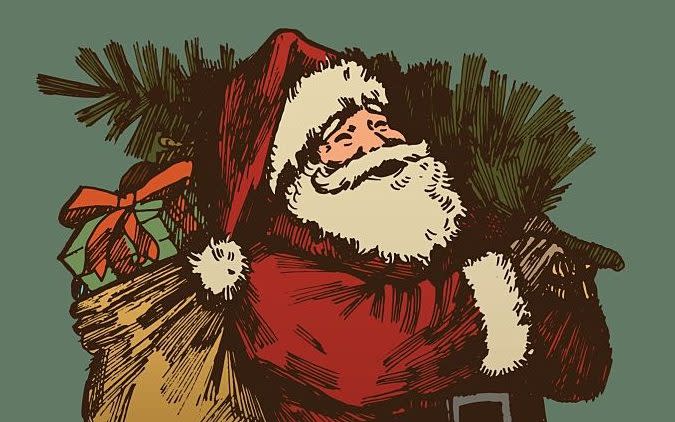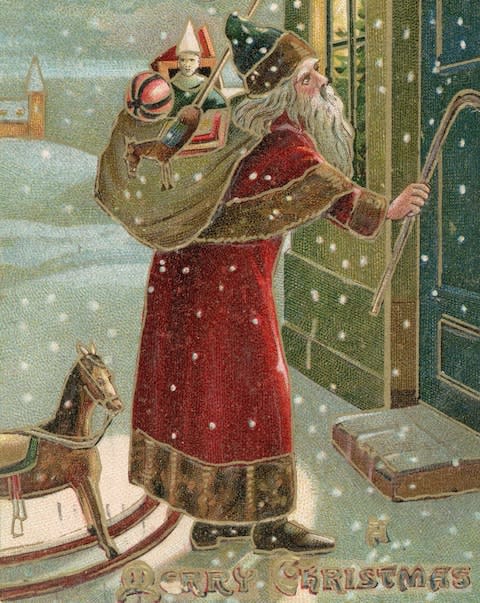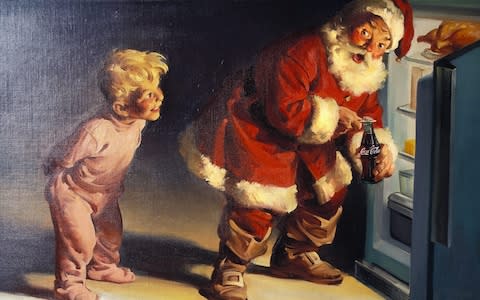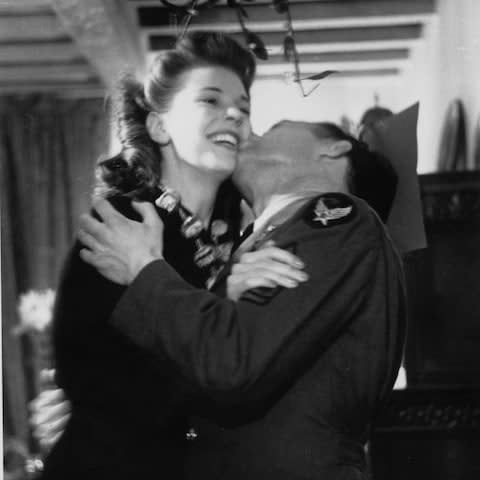Christmas traditions: Advent calendars, mince pies and the story of Santa Claus

From decorating Christmas trees and hanging up stockings to pulling crackers and eating mince pies, us Britons celebrate the festive season with a range of rituals and traditions, yet we seldom stop to ask why.
Discussion of the origins of such holiday customs tend to stall with: “Wasn’t it all invented by the Victorians? Or the Germans? Or was it Coca-Cola?”
In fact, many date back to ancient times and have been influenced along the way by religion, pop culture and the commercialisation of Christmas.
Here is everything you need to know about Christmas traditions, including the history behind the festive practices and the story of the beloved Santa Claus.
Why do we have Christmas trees?
Romans used fir trees to decorate their temples during Saturnalia, a feast in honour of Saturn, the god of agriculture, and the predecessor to Christmas.
In northern Europe, people planted cherry or hawthorn plants, or created pyramids of fruit or candles. Evergreen trees were thought to keep away evil spirits and illness, and were put up during the winter solstice, the shortest day of the year, to remind them that the spring would return.
Another predecessor was the Paradise tree, a fir decorated with apples to represent the Garden of Eden on Adam and Eve’s day, which fell on December 24.
It is thought the first person to bring a tree indoors was the German theologian Martin Luther. Walking through a forest, he was so taken by the beauty of stars twinkling through the pines that he took a tree home and attached candles to each branch.
Germans decorated their trees with edible goods and glass decorations. Tinsel was originally made in Germany from thin strips of silver. Electric lights were first created in 1895 by Ralph Morris, an American telephonist.
Christmas trees made it to Britain in the 1830s, and in 1841, Prince Albert set up a tree in Windsor Castle. In 1846, the Royal family was sketched standing around their Christmas tree, after which the practice became very fashionable.
Read our guides on the best real Christmas trees and artificial Christmas trees to buy this year.
The story behind Santa Claus and Christmas stockings
The story of Father Christmas starts with Saint Nicholas, a bishop who lived in Myra, Asia Minor (what is now known as Turkey) in the fourth century. He had a reputation for giving to the poor and being kind to children.
Legend has it that Saint Nicholas dropped a bag of gold down the chimney of a poor man who could not afford his daughter’s dowry. The bag fell into a stocking that had been left by the fire to dry.
He also dropped a bag of gold for the second daughter. The father tried to find out who this mystery benefactor was, and when he did, Saint Nicholas begged him not to reveal his identity.
Word soon got out, and when anyone received a secret gift, it was always thought to be Saint Nicholas.

However, in the 16th century, the stories of St Nicholas grew unpopular in northern Europe and new images of Father Christmas, or Old Man Christmas, circulated instead.
An early example of Father Christmas in literature appears in Ben Jonson’s play of 1616, Christmas, His Masque. An old bearded man enters through the chimney, rather than the door, as this was the entrance for Pagan trespassers such as evil spirits. His sons and daughters are named Carol, Misrule, Gambol, Minced-Pie and Baby-Cake.
The Victorians rediscovered the stories of Saint Nicholas and used the legend in poetry and prose. In A Visit from St. Nicholas, a poem written by Clement Moore in 1822, he flew from house to house in a sleigh drawn by eight reindeer, to fill stockings.
Thomas Nash drew a series of cartoons of him living at the North Pole, with a workshop for building toys and a large book with the names of naughty and nice children.
Some European countries also celebrate Saint Nicholas’ Day on December 6, when they leave out clogs or shoes to be filled with presents and sweets.
Why does Santa wear red?
The legend goes that Santa’s suit is red because of a successful advertising campaign for Coca-Cola that featured Father Christmas wearing red robes with a white trim, the soft drink’s colours.
But the red and white actually derive from the colours of Saint Nicholas. Over time, the bishops’ red and white robes were replaced by a fur-trimmed suit. Historians argue that bishops’ robes appeared in many different colours but the red one came to be linked to Father Christmas during the 19th century.
Saint Nicholas was drawn throughout history in various forms: thin, intellectual and even frightening. It was Coca-Cola’s adverts that created the image of the rotund, jolly, white-haired man we’re all familiar with today.

Why do we eat turkey on Christmas Day?
Goose, boar and peacock have all been popular Christmas meats over the centuries, but nowadays, turkey reigns supreme as the traditional Christmas Day meal in the UK.
Legend has it King Henry VIII was the first English monarch to eat turkey on Christmas Day, popularising it among the upper classes after the bird was imported from America. The introduction of refrigerators in the 1950s brought the dish into the mainstream and onto dining tables around the country.
However turkey, stuffing and pigs in blankets are not the norm for the rest of the world; most countries have different classic Christmas meals. The Swedes often eat pickled herring and meatballs, in Mexico they eat tamales and in Southern Italy they favour fried eel.
Why do we eat mince pies?
Mince pies were known as Christmas pies, or crib pies, as their oblong shape was meant to resemble Jesus’ cradle. The pies were initially made of meat, usually mutton, and influenced by crusaders who came back from the Middle East with spices.
Samuel Pepys wrote about them, but in his time they were much more savoury than we are used to now. In the 18th century the pies became sweeter, with the import of sugar from slave plantations in the West Indies.
Why do we eat Christmas pudding?
Christmas pudding, sometimes known as figgy pudding, originates from the 14th century. But unlike the festive treat that takes over our supermarket shelves today, Christmas pudding once existed as a porridge called "frumenty".
Made of beef, mutton, currants, wines and spices, frumenty was typically eaten as a fasting meal in preparation for the Christmas celebrations.
Eggs, breadcrumbs, dried fruit, beers and spirits were later added to the Christmas dish, which meant by 1595, it had transformed into a plum pudding.
In 1650, it became a festive dessert, but in 1664, it was banned by the Puritans. It didn't make a return until 1714, when King George I re-introduced it as part of the traditional Christmas meal.
By the Victorian times, it had evolved into the rich, delicious pudding we love today.
What is Advent and where do Advent calendars come from?
The season of Advent is traditionally celebrated by Christians in the four weeks leading up to Christmas Day. It begins on the Sunday that falls between November 27 and December 3 each year and symbolises the "coming" of Christ.
The Christian message has since evolved into a modern day tradition, when both children and adults count down the days to December 25 with their own Advent calendars.
This festive practice originates from Germany, and dates back to the early 19th Century, when German Protestants marked the days of Advent by burning a candle or drawing on walls with chalk.
The first handmade, wooden Advent calendar was created in 1851, and by the early 20th century, the first printed Advent calendars had been created.
Gerhard Lang later added small doors to the Advent calendars in the 1920s, while short Bible verses and traditional pictures were added behind the doors in the 1930s.
Advent calendars later disappeared for a short period, due to the rationing of cardboard and a calendar printing ban imposed by the Nazis, but made a return when Richard Sellmar of Stuttgart obtained a permit from the US to begin printing them again.
By the late 1950s, Chocolate Advent calendars were popular and nowadays, the cardboard Christmas countdowns contain a variety of treats, including beauty products, children's toys, gin and even cheese.

Why is it called Boxing Day?
Boxing Day is not to do with Santa’s discarded wrapping and boxes, but has its origins in the practice of giving presents and money to poor people.
One legend has it that the British upper classes gave tradespeople and servants boxes of food and fruit as a seasonal tip. Others believe that boxes full of alms to give to the needy were left in churches over the Christmas period, and on Boxing Day these were collected and distributed.
Why do we kiss under mistletoe?
Its original usage was far from romantic: the parasitic plant was viewed by ancient cultures as a cure for ailments such as menstrual cramps and spleen disorders. Eating the berries actually causes vomiting and stomach pain because they contain toxic substances.
Druids viewed it as a symbol of life as it grew even during the winter. It was consumed to increase fertility and used to decorate houses during winter and summer solstices. In Norse mythology mistletoe has connotations of love and friendship.
It is unclear exactly where the link between Christmas and mistletoe arose, however. By the 18th century the practice of hanging mistletoe at Christmas began in Britain. It was bad luck if you refused to kiss someone under the mistletoe.

Charles Dickens described in the Pickwick Papers how young women "screamed and struggled, and ran into corners, and did everything but leave the room, until … they all at once found it useless to resist any longer and submitted to be kissed with a good grace."
Why do we send Christmas cards?
In 1843, Sir Henry Cole, a civil servant and educator, and his friend John Callcott Horsley, an artist, produced the first Christmas card. Horsley's illustration shows three generations of the Cole family raising a toast, and also includes two additional scenes, representing the acts of giving.
The design was printed on cards, with Cole successfully publishing and selling one thousand copies for a shilling each.
The development of printing processes meant Christmas cards grew popular during the Victorian era, with new, distinctive designs on sale in stationers and bookshops. In fact, many of the designs that are seen on Christmas cards today, including robins and snow scenes, originate from this period.
The Half Penny Post, established in 1894, also increased Christmas card sales further and popularised more affordable postcard formats too.
Why do we pull crackers?
Crackers are a Victorian invention, created by a sweet maker who wanted a novel way of selling his wares after sales slumped.
The story goes that Tom Smith was watching a fire crackle and thought of how the packaging could “crack”. The sweets were replaced by trinkets and jokes, and paper hats were introduced. They were initially sold as “cosaques”, named after Russian Cossack soldiers who would fire their guns in the air while on horseback.


